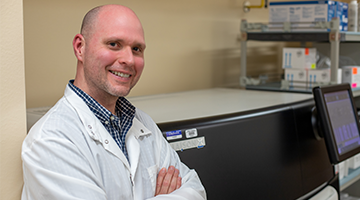Testing Speed

Randy Schillers, Missouri State Public Health Laboratory
Manager of the MSPHL Virology Unit
Testing Speed
Strengthening laboratory infrastructure
Impact: statewide
Testing Speed
Strengthening laboratory infrastructure: The Missouri State Public Health Laboratory increased disease testing capacity and speed
During the COVID-19 pandemic, the team at the Missouri State Public Health Laboratory (MSPHL) found themselves desperately looking for ways to improve response times and efficiencies across the board. Team members wanted to increase testing capacity at rates and in ways that the current resources couldn’t handle. The key to keeping up with testing demand was to automate manual processes and scan single samples for multiple viruses at one time.
Randy Schillers, laboratory manager for the Virology Unit within the MSPHL, describes the ability to test for more than one organism as breaking the gap.
"We were able to purchase machinery that could perform things fast, accurate, and, for some of our equipment, a broader spectrum," Schillers explained. "Yes, you are looking for COVID-19, but what if it wasn’t? We now have the ability to test for things beyond just one organism."
The Virology Unit expanded its testing through two new machines. The BioFire Troch FilmArray system includes batch testing for respiratory organisms, gastrointestinal bacteria and even some parasite testing. The DiaSorin Liaison XL machine can condense multiple testing systems and allow for increased speeds of around 170 samples an hour for some tests.

The previous testing equipment didn’t provide the speed or the spectrum of different organisms needed to complete testing. The COVID-19 funding opened the door to upgrade the equipment, turning one-time funding into a long-term improvement for future disease outbreaks.
"Speed and spectrum," Schillers said. "Getting these results in a faster turnaround means medical staff and our epidemiological staff, are able to respond quicker. And quicker response means you can get started on treatments, helping everyone in the long run."
Beyond COVID-19, these two pieces of equipment can be used to accelerate diagnosis and ultimately treatment for some of our most vulnerable populations in Missouri, including residents of long-term care facilities.
